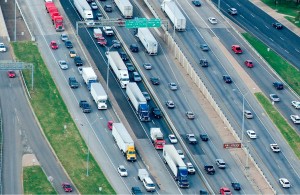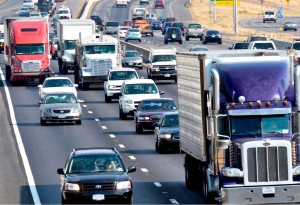In the Austin area, more than 220,000 vehicles travel on I-35 on a daily basis. In contrast, SH 130, the tolled bypass around Austin only carries 40,000 vehicles daily. Why do more vehicles choose the I-35 route? What would make travelers, particularly big trucks, more likely to use SH 130?
Associate Research Scientist Tina Geiselbrecht at TTI’s Transportation Policy Research Center recently published a report titled Incentives for Truck Use of SH 130 aimed at understanding the trucking industry’s use of toll roads and the possibility of diverting large trucks to SH 130. Researchers conducted a traffic analysis and found only 14 percent of I-35 traffic volume is vehicles traveling through the region without stopping, and of that volume, only 1 percent are trucks. The other 86 percent of vehicles are local I-35 travelers.
Watch our short video where we explain the I-35 and SH 130 traffic data analysis conducted as part of this study.
The traffic data analysis shows, overall, SH 130 carries very few trucks. To better understand how to increase truck traffic on SH 130, Geiselbrecht and her team studied incentives for truck use of toll road SH 130.
Geiselbrecht and her team interviewed trucking industry leaders to get their thoughts on the following potential incentives:
- higher speed limits on SH 130;
- the presence of nearby amenities and associated facilities;
- the provision of speed and travel times for alternate routes;
- use of long combination vehicles (LCVs); and,
- toll discounts.

The findings suggest many of these potential incentives would not cause a shift to SH 130. Because some operators say it’s not safe to operate large vehicles at high speeds and speed tends to increase the cost of a trip in terms of fuel consumption, higher speed limits are not an effective incentive. Providing travel time information near access points to SH 130 doesn’t motivate truck drivers to use toll roads either because interviews with industry professionals found they already use internal systems that show them travel times and alternate routes.
“This study supports short- and long-term mobility policy and planning strategies on how to move freight more efficiently in and through Texas. Although diverting truck traffic to uncongested toll roads is positive, the literature, traffic data and interviews revealed the trucking industry is reluctant to use tolled facilities,” Geiselbrecht says. “So it may be a good idea to also think about how to get passenger vehicles to divert to SH 130 since they make up the majority vehicle volume on I-35.”

A companion effort led by TTI Research Scientist Jolanda Prozzi looked at truck travel-cost estimates on tolled and non-tolled facilities in Central Texas. Researchers studied two different routes—Georgetown to San Marcos and Georgetown to Austin-Bergstrom International Airport—via two different roadwayss: I-35 and SH 130, and under various speeds and tolling rate scenarios. For the latter trip, the routes from both I-35 and SH 130 included use of SH 71 as well.
Only the Georgetown to Austin-Bergstrom Airport trip proved less expensive overall than the non-tolled route (I-35 and SH 71), and only under the following conditions:
- During the PM peak if the truck tolls were reduced to the car toll rate.
- During all times of day if the truck tolls were removed.
Without those modifications, the tolled route remained more expensive for truckers than the non-tolled route for all travel times and toll rates.